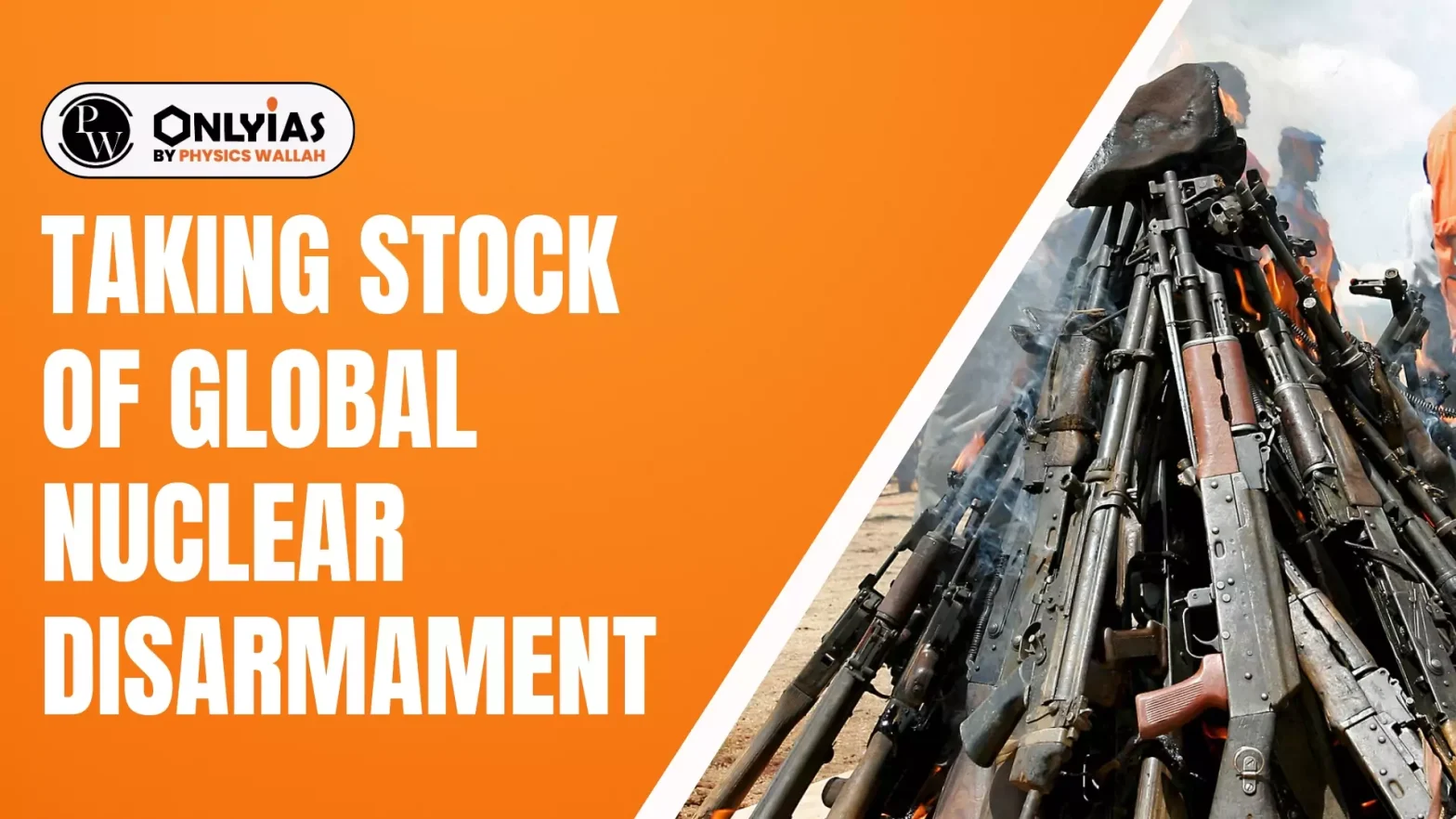Albert Einstein famously stated, “I do not know with what weapons World War III will be fought, but World War IV will be fought with sticks and stones.” This profound statement highlights the catastrophic potential of nuclear weapons, suggesting that a third world war involving such armaments could result in unparalleled destruction, leaving nothing but devastation in its wake. The nuclear warfare could possibly destroy civilization as we know it, rendering advanced technology and weapons useless in a post-apocalyptic world where humanity may be reduced to primitive survival. In light of this, the discourse surrounding nuclear disarmament becomes not just a political necessity but a moral imperative, as the consequences of inaction could be nothing short of annihilation.
Enroll now for UPSC Online Course
Treaties to Prevent the Development of Nuclear Weapons
1. Treaty on the Non-Proliferation of Nuclear Weapons (NPT)
- Introduction: The Non-Proliferation Treaty (NPT) was introduced to prevent the spread of nuclear weapons and promote nuclear disarmament. It was opened for signature in 1968 and came into force in 1970. The treaty represents a landmark international agreement aimed at preventing the escalation of nuclear weapons, ensuring that nuclear energy is used only for peaceful purposes, and fostering global cooperation in nuclear disarmament.
- Nuclear Weapon States and Their Obligations: The NPT recognizes five nuclear-weapon states (NWS) – the United States, Russia (formerly the USSR), France, China, and the United Kingdom – all of which are permanent members of the UN Security Council. These states are obligated under the treaty to pursue disarmament negotiations in good faith and to not transfer nuclear weapons or nuclear technology to non-nuclear weapon states (NNWS).
- Obligations for Non-Nuclear Weapon States: Non-nuclear weapon states (NNWS) that are signatories to the NPT are required to refrain from acquiring or developing nuclear weapons. In exchange for their commitment, they are assured access to nuclear technology for peaceful purposes, such as energy production, under strict international safeguards. This framework is designed to prevent the proliferation of nuclear weapons while allowing for the beneficial use of nuclear technology.
- Limitations and Challenges of the NPT:
- Discriminatory: The NPT has faced significant criticism for creating a division between nuclear “haves” and “have-nots,” with critics arguing that it perpetuates an unequal global power structure. The United States has defended the treaty as the most practical approach to nuclear disarmament currently available. However, countries like India have refused to sign the treaty, citing its discriminatory nature. Pakistan and Israel also did not sign the treaty, further highlighting the perceived inequities and limitations of the NPT framework.
- Misuse: North Korea’s involvement with the NPT illustrates both compliance and violation. Initially, North Korea signed the treaty and received nuclear technology under the guise of peaceful purposes. However, it withdrew from the NPT in 2003 and developed nuclear weapons, defying international norms.
- Failed to build global Consensus: India and Pakistan, both non-signatories, conducted nuclear tests in 1998, openly demonstrating their nuclear capabilities and challenging the effectiveness of the NPT in preventing nuclear proliferation.
Despite the treaty’s intent, little progress has been made toward global nuclear disarmament, and some nations, such as China, continue to expand their arsenals. Additionally, countries like Iran are actively pursuing uranium enrichment, raising concerns that they could soon emerge as nuclear powers, further undermining the treaty’s objectives.
| Note: Disarmament refers to the reduction or elimination of nuclear weapons. NPT is credited positively in this regard. |
2. Treaty on the Prohibition of Nuclear Weapons (TPNW)
- Background: In 2017, scientists and NGOs collaborated to create the Treaty on the Prohibition of Nuclear Weapons (TPNW). This treaty is considered more idealistic than earlier more practical treaties.
- Goal: The primary goal of the TPNW is to completely eliminate nuclear weapons from the planet. However, achieving this may not be fully possible, as nuclear states might not relinquish their arsenals easily.
- Scope: The TPNW is more ambitious than previous treaties, as it prohibits the development, testing, production, stockpiling, transfer, or use of nuclear weapons.
- Signatories: As of July 2024, the TPNW had 70 states parties, with an additional 27 states having signed but not yet ratified the treaty. Upon ratification by these additional states, the total would rise to 97, representing approximately 50% of the states bound by international treaties on weapons of mass destruction.
- Current Status: Many nuclear powers and their allies have still not signed or ratified the TPNW. However, discussions on this treaty are on the agenda for the upcoming UN General Assembly session. Some observers are anticipating how nuclear power states will respond to this treaty. If they express support, there may be hope for disarmament as a possible future. Conversely, a lack of support would diminish hopes for the elimination of nuclear weapons.
- Recently, a group of former leaders and officials from NATO states has urged their countries to support the Treaty on the Prohibition of Nuclear Weapons (TPNW). This includes notable figures like former NATO Secretaries-General and a former UN Secretary-General.
- Limitations of the TPNW: Currently, there are no penalties or enforcement mechanisms in place for states that sign the TPNW but subsequently use nuclear power. The treaty lacks a robust implementation framework, which makes it difficult to enforce compliance.
Check Out UPSC CSE Books From PW Store
India’s Approach to Nuclear Weapons
- India never signed the Treaty on the Non-Proliferation of Nuclear Weapons (NPT); however, it has never actively undermined the treaty. While India did develop its own nuclear weapons, it has not shared this technology with other states. India has maintained that it follows the treaty’s provisions in spirit, even if not in letter.
- India has benefitted from the existence of the NPT, as it has prevented several states from developing nuclear weapons. The new treaty, the Treaty on the Prohibition of Nuclear Weapons (TPNW), could similarly assist India.
Conclusion
While nuclear states may choose to remain outside the Treaty on the Prohibition of Nuclear Weapons (TPNW), their passive acceptance of the treaty’s principles can enhance its legitimacy. The TPNW has the potential to stigmatize the use of nuclear weapons, much like the global stance against chemical weapons. This growing stigma can lead to international isolation and condemnation for states that engage in nuclear threats or tests, as evidenced by the recent Russia-Ukraine conflict. Even allies like China have shown disapproval of nuclear rhetoric, highlighting the treaty’s influence.
![]() 26 Sep 2024
26 Sep 2024

